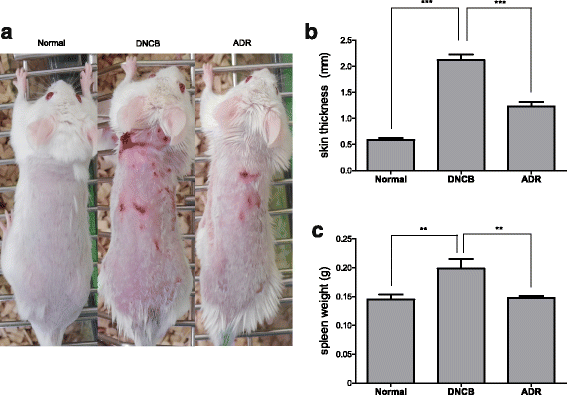Effects of Angelicae dahuricae Radix on 2, 4-Dinitrochlorobenzene-Induced Atopic Dermatitis-Like Skin Lesions in mice model
- PMID: 28173791
- PMCID: PMC5297152
- DOI: 10.1186/s12906-017-1584-8
Effects of Angelicae dahuricae Radix on 2, 4-Dinitrochlorobenzene-Induced Atopic Dermatitis-Like Skin Lesions in mice model
Abstract
Background: Atopic dermatitis (AD) is an inflammatory, chronically relapsing, and intensively pruritic skin disease that affect 10-30% of the global population. Angelicae dahuricae Radix (ADR) has been reported to be anti-inflammatory in Korean Medicine. In the present study, we investigated whether ADR suppresses the progression of AD in animal model.
Methods: AD was induced by 2, 4-Dinitrochlorobenzene (DNCB). ADR was orally administered to mice to study the effect of ADR on AD. Histological Analysis, immunohistochemistry, blood analysis, RT-PCR, and ELISA assay were performed.
Results: ADR significantly suppressed AD-like symptoms in BALB/c mice: ADR decreased skin thickness and spleen weight of mice. ADR reduced infiltration of mast cells, inflammatory cells and CD4+ cells into mouse skin. ADR lowered the number of WBCs in the blood of mice. ADR reduced the levels of IgE, IL-6, IL-10 and IL-12 in mice serum. ADR down-regulated mRNA expression of IL-4, IL-6 and TNF-α in mouse skin tissue.
Conclusion: Our present study clearly indicates that ADR suppresses the progression of AD induced by DNCB in BALB/c mice. This suggests that ADR might be a useful drug for the treatment of AD.
Keywords: 2, 4-Dinitrocholrlbenzene; Angelicae dahuricae Radix; Atopic dermatitis; BALB/c mice; Cytokine; Inflammation.
Figures







References
-
- Vale S, Smith J, Paterson T, Bramah S, Butt C. Australasian Society of Clinical Immunology and Allergy (ASCIA) 26th Annual Conference, 9–12 September 2015, Adelaide, Australia. Intern Med J. 2015;45(Suppl 4):1–30. - PubMed
MeSH terms
Substances
LinkOut - more resources
Full Text Sources
Other Literature Sources
Medical
Research Materials

